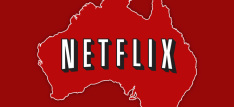How Netflix could help save the local media industry
 While many predict the official arrival of global streaming giant Netflix in Australia will damage local media players Kevin Dillon argues it might actually end up being a boon for the savvy ones.
While many predict the official arrival of global streaming giant Netflix in Australia will damage local media players Kevin Dillon argues it might actually end up being a boon for the savvy ones.
I first encountered the notion of online DVD rental between pints of Sierra Nevada at the Black Watch (a dive bar in Los Gatos, California). It was late 1999, and my friends and I were toasting my two years survival in Silicon Valley. Those were halcyon Internet bubble days in the Bay Area. Notable successes (Amazon) were emerging. Others (webvan) burned brightly but briefly. Most wouldn’t see the other side of the 2000 tech wreck.My friends were two of the few dozen employees at an early stage start-up just down the road. The online DVD rental service their company offered was hugely convenient and affordable, and I was a rapid convert. Movies and TV series that just could not be found on US TV leapt out of their ruby red envelopes and into my DVD player.
The start-up, of course, was Netflix. And their pivot from DVD to streaming is the stuff of Internet legend.
 Today’s Netflix employs 2,000 people and has squirrelled away US$1.7 billion in cash. This year they will invest more than $600 million on marketing, $400 million on technology, and close to $3 billion on new content. Their total content spend runs at $8.9 billion. They have survived – and prospered – despite the tech wreck and several other major business challenges. The company is well led and chock-a-block with talent. The only red you will find there is in their branding!
Today’s Netflix employs 2,000 people and has squirrelled away US$1.7 billion in cash. This year they will invest more than $600 million on marketing, $400 million on technology, and close to $3 billion on new content. Their total content spend runs at $8.9 billion. They have survived – and prospered – despite the tech wreck and several other major business challenges. The company is well led and chock-a-block with talent. The only red you will find there is in their branding!


Many of our friends have Netflix in OZ now. (mainly tech savvy at the moment due to the geo block you must adjust) Netflix is great, plus true HD. Lacks many new releases but other than that has made Foxtel quiver and lower its prices. Will make the rest of the country smarten up also in free to air. No ads is the reason it shines. Foxtel you pay plus you get ads. No wonder so many people un hooked include ourselves.
Thanks Kevin, there have been a lot of articles written on this subject recently but this one particularly is lucid, persuasive, and non-hysterical. Thanks a lot.
We need a sustainable business model for content producers that doesn’t rely on access to the scarce discovery models that prevail on traditional broadcast (paid or free) TV. If netflix can enable discovery and monetisation of innovative new programming alongside the big hitters then everyone benefits. If it can;t then youtube will just win, but it will take longer. With foxtel locking up the programming though it hard to see it working. We need to ensure open access to programming irrespective of transport channel ala the FCC reg that opened up content to both satellite and cable (and more recently, IP).
If the ACCC would get Telstra to divest foxtel then we would have real competition and a player with the incentives and scale to make this happen.
TV’s Kodak moment is coming, only question is what pushes it over the edge, and when. However unlike photos, TV has a lot of regulation propping it up.
Interesting point about economies of scale such as whether future local links with the huge SVOD companies are needed. Personally I’ve always had a VPN and with netflix costing $10 AUD; actually $5 as you can be watching on two screens at once so I split it with my brother. That sort of price is unbeatable.
Thanks Jack, Jennifer – yep, that is why scale is SO important. If you are going to be an SVOD company you will be charging $10/month or thereabouts – that means you need a lot of subscribers in order to be profitable. Netflix is already commissioning new content – which wouldn’t have otherwise been funded – in places like France and adding that into their global library. Every possibility they might do the same here.
Not sure that TV has a deep Kodak moment coming Paddo – especially here in Australia – linear TV so effectively assembles massive, synchronous audiences around events like sports and news. And it is so well socialised too. It is changing, for sure, and needs to position itself for 4K content distribution. There is considerable scope for more innovation around their broadcast events too (hinted at one possibility in the article). There is a strong future for savvy broadcasters.
On ads and SVOD Jennifer, down the track we may see some SVOD providers offer opt-in advertising in exchange for discounted subscription fees. It’d be interesting to see the A/B results for that one 🙂
Thanks to you too Al!
The tricky issue for most of the readers of this site is that Netflix doesn’t carry advertising. Which is a bit of a shit if you’re in the business of making, producing, planning, placing, measuring, airing or requiring advertising.
Interesting to see what content deals they are able to tie up. Their ongoing war with HBO will be a huge problem meaning no current or classic HBO shows
Just gimme direct access, producer to consumer and cut all the parasites out of the equation, advertisers, redistributers etc etc
How many industries are based on “value-adding” nothing in the digital age? It’s ridiculous. I’m not going to pay Foxtel for Game of Thrones, they had nothing to do with it’s production and everything to do with its so-called artificial scarcity.
Stop looking for ways to scam dollars off other people’s content and turn your collective talents to making some. Then, I’ll happily reward you with cash.
Bob, do you realise that the producer needs financial backing in order to produce that content BEFORE you can consume it?
It sure as hell isn’t coming from the consumer via KickStarter etc.
And your $10 a month ain’t going to go too far – maybe a cup of coffee for two lucky ones among a crew of 50+ one morning a month.